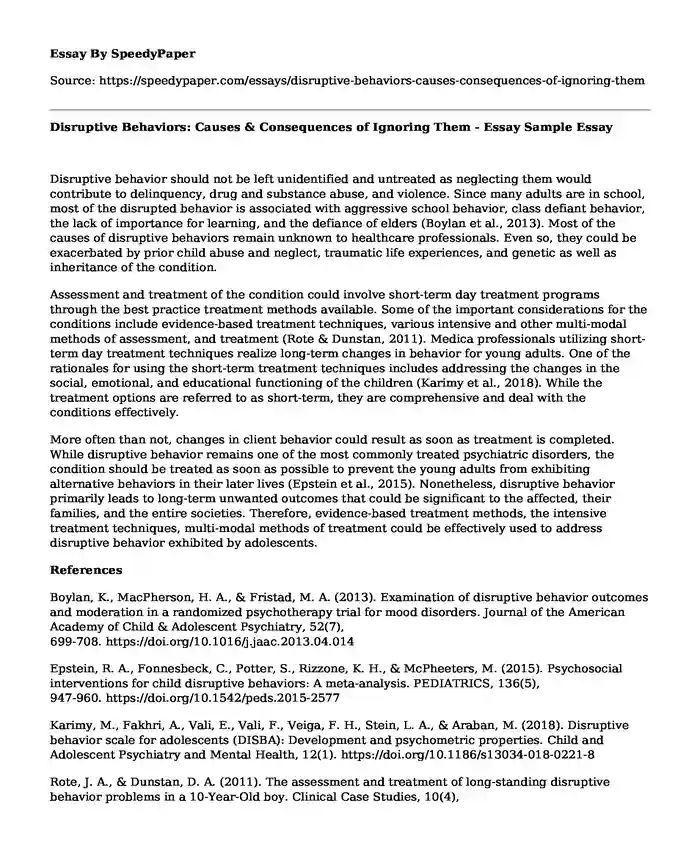
| Type of paper: | Essay |
| Categories: | Behavior |
| Pages: | 2 |
| Wordcount: | 390 words |
Disruptive behavior should not be left unidentified and untreated as neglecting them would contribute to delinquency, drug and substance abuse, and violence. Since many adults are in school, most of the disrupted behavior is associated with aggressive school behavior, class defiant behavior, the lack of importance for learning, and the defiance of elders (Boylan et al., 2013). Most of the causes of disruptive behaviors remain unknown to healthcare professionals. Even so, they could be exacerbated by prior child abuse and neglect, traumatic life experiences, and genetic as well as inheritance of the condition.
Assessment and treatment of the condition could involve short-term day treatment programs through the best practice treatment methods available. Some of the important considerations for the conditions include evidence-based treatment techniques, various intensive and other multi-modal methods of assessment, and treatment (Rote & Dunstan, 2011). Medica professionals utilizing short-term day treatment techniques realize long-term changes in behavior for young adults. One of the rationales for using the short-term treatment techniques includes addressing the changes in the social, emotional, and educational functioning of the children (Karimy et al., 2018). While the treatment options are referred to as short-term, they are comprehensive and deal with the conditions effectively.
More often than not, changes in client behavior could result as soon as treatment is completed. While disruptive behavior remains one of the most commonly treated psychiatric disorders, the condition should be treated as soon as possible to prevent the young adults from exhibiting alternative behaviors in their later lives (Epstein et al., 2015). Nonetheless, disruptive behavior primarily leads to long-term unwanted outcomes that could be significant to the affected, their families, and the entire societies. Therefore, evidence-based treatment methods, the intensive treatment techniques, multi-modal methods of treatment could be effectively used to address disruptive behavior exhibited by adolescents.
References
Boylan, K., MacPherson, H. A., & Fristad, M. A. (2013). Examination of disruptive behavior outcomes and moderation in a randomized psychotherapy trial for mood disorders. Journal of the American Academy of Child & Adolescent Psychiatry, 52(7), 699-708. https://doi.org/10.1016/j.jaac.2013.04.014
Epstein, R. A., Fonnesbeck, C., Potter, S., Rizzone, K. H., & McPheeters, M. (2015). Psychosocial interventions for child disruptive behaviors: A meta-analysis. PEDIATRICS, 136(5), 947-960. https://doi.org/10.1542/peds.2015-2577
Karimy, M., Fakhri, A., Vali, E., Vali, F., Veiga, F. H., Stein, L. A., & Araban, M. (2018). Disruptive behavior scale for adolescents (DISBA): Development and psychometric properties. Child and Adolescent Psychiatry and Mental Health, 12(1). https://doi.org/10.1186/s13034-018-0221-8
Rote, J. A., & Dunstan, D. A. (2011). The assessment and treatment of long-standing disruptive behavior problems in a 10-Year-Old boy. Clinical Case Studies, 10(4), 263-277. https://doi.org/10.1177/1534650111410228
Cite this page
Disruptive Behaviors: Causes & Consequences of Ignoring Them - Essay Sample. (2023, Oct 29). Retrieved from https://speedypaper.net/essays/disruptive-behaviors-causes-consequences-of-ignoring-them
Request Removal
If you are the original author of this essay and no longer wish to have it published on the SpeedyPaper website, please click below to request its removal:
- What Is Human Behavior - Essay Sample
- Essay Sample on Revisions to Benefits and Compensation Package
- Essay Sample on Religion and Religious Oppression
- Paper Example. Biological Domain
- Socrates: No One Does Evil Intentionally. Free Essay
- Free Essay: Engaging With Community and Organization
- Essay on Danger of a Single Story: Chimamanda Adichie's 2009 TED Talk
Popular categories




